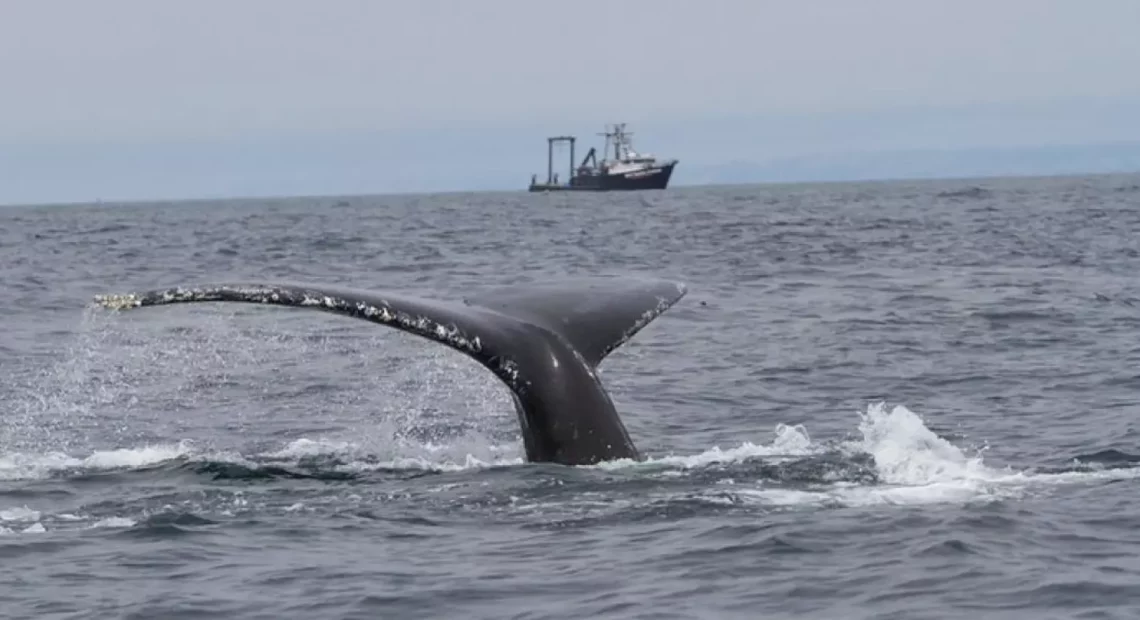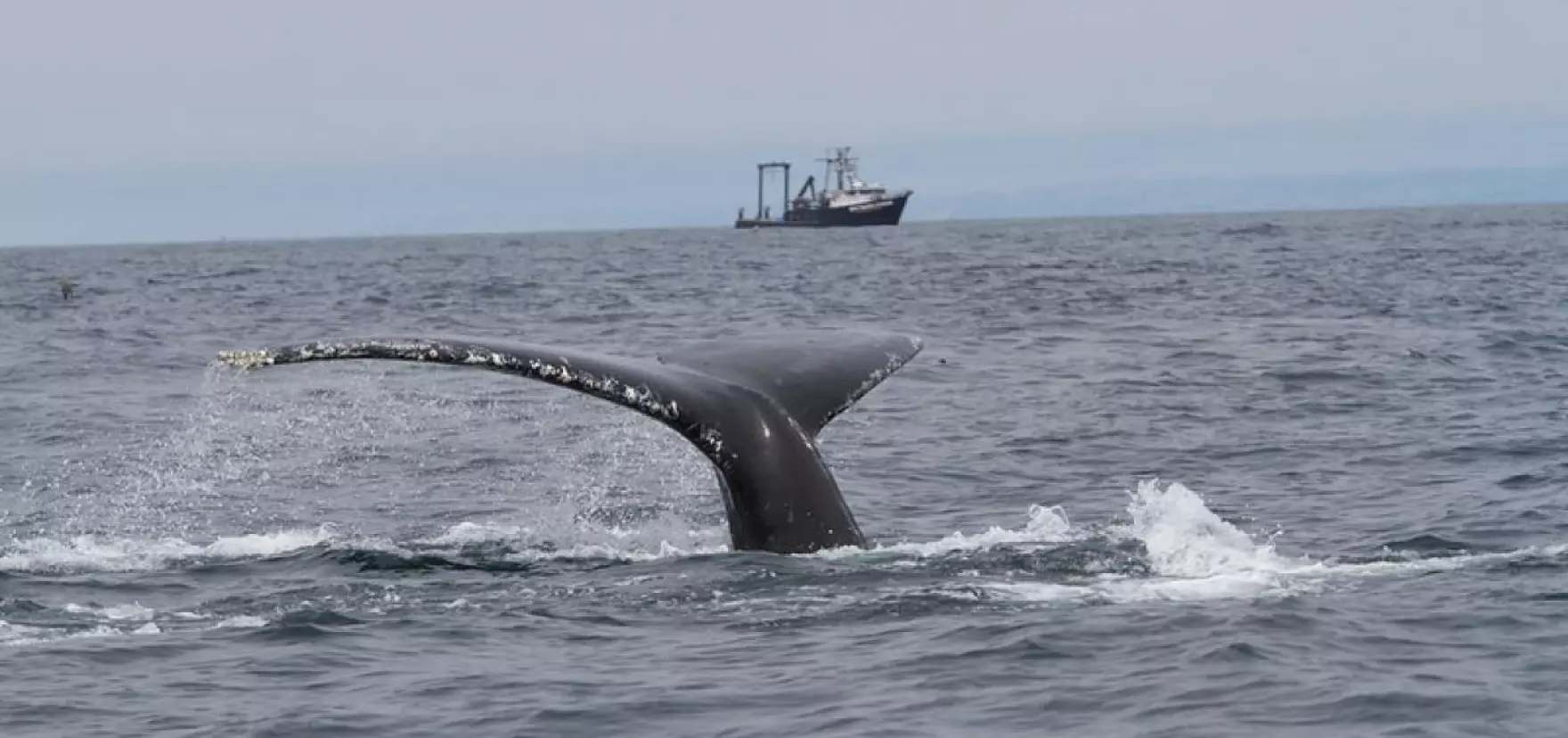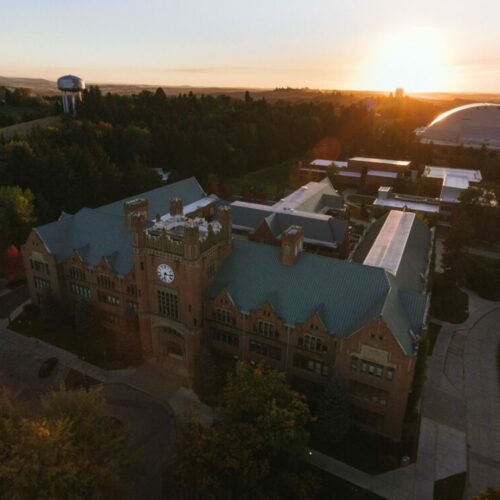The federal government has commissioned Oregon State University to look into the possible impacts of offshore wind farms on marine wildlife. In the first year of this four-year project, the researchers spotted sizable numbers of seabirds and whales — including the largest animal on Earth — in the Oregon and Northern California areas that could one day host floating wind farms.
The OSU researchers are taking to the sea, to the air and listening underwater to document which seabirds, whales and dolphins forage in and around the parcels put up for lease by the Interior Department for offshore wind farm development.
“The (continental) shelf and the slope have high abundance and high density of marine mammals and seabirds,” reported OSU Marine Mammal Institute director Lisa Ballance after the first two of seven planned research cruises were in the books.
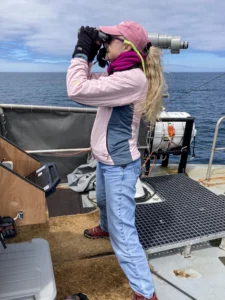
Dr. Lisa Ballance surveys for marine mammals and seabirds during an August research cruise. Credit: Barb Lagerquist/ OSU Marine Mammal Institute
“There are quite a lot of large whales out there, quite a number,” said Ballance, who serves as principal investigator on the project. “Humpbacks are quite abundant. Increasingly, blue whales are quite abundant. We also see a whale that is less familiar to most people called a sei whale. It looks a lot like a blue whale, not quite as big but a very large animal.”
Blue whales, sei whales, as well as some sub-populations of humpbacks are federally-listed as endangered. The Pacific Northwest’s critically endangered Southern Resident killer whales also travel along the outer coast seasonally.
The array of seabirds spotted by the researchers included threatened marbled murrelets along with impressive long-distance travelers such as black-footed albatrosses and Laysan albatrosses. Ballance reserved special admiration for the abundant sooty shearwaters, a seasonal visitor to Pacific Northwest waters that migrate all the way from breeding colonies near New Zealand.
Ballance said her team needs to do a lot more analysis before she would consider making any statements about whether anchoring massive floating wind turbines amid this maritime abundance would create problems.
A spokeswoman for German multinational energy company RWE Renewables, the winning bidder for one of the Northern California offshore leases, said it was still very early in the site development process. For that reason, the company declined Monday to comment on the initial wildlife survey results.
Early on, the federal Bureau of Ocean Energy Management identified the risk of whale entanglements in floating platform moorings and cabling as a concern. The agency contracted with the National Oceanic and Atmospheric Administration to create a computer simulation of whale interactions with different wind farm configurations, the results of which have not yet been published.
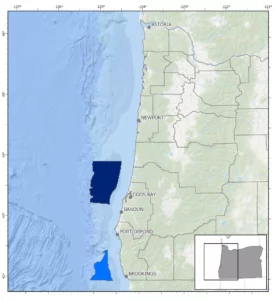
Expanses of ocean near Coos Bay (navy blue) and Brookings (sky blue) are the federal government’s top candidates for Oregon offshore wind energy leases. Credit: Bureau Of Ocean Energy Management
“It is important to note that a federal offshore wind lease only grants a company the exclusive right to submit plans to BOEM for activities on their lease. It does not grant approval for the construction of an offshore wind facility,” BOEM public affairs officer John Romero said in an email Saturday.
Earlier this month, the federal treasury reaped $757 million from auctioning leases to five patches of ocean off Morro Bay and Humboldt County, California. The Bureau of Ocean Energy Management tentatively plans to auction two more leases off of Coos Bay and Brookings, Oregon, sometime in the second half of 2023. The lease areas begin around 14 miles off the coastline and extend to 46 to 65 miles offshore. This means the wind farms should be out of sight from shore on all but the clearest days.
The OSU study is just one of more than a dozen commissioned by federal agencies to scope out the environmental, economic and social changes that large-scale renewable energy development might bring to the Pacific Coast. The objective, as laid out by the U.S. Department of Energy last year, is to “inform offshore wind siting, permitting and help protect wildlife and fisheries as offshore wind deployment increases.”
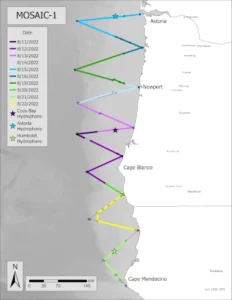
Tracklines of the OSU research vessel Pacific Storm during an August survey of marine mammals and seabirds. Credit: Marine Mammal Institute/ OSU
The $2 million grant to the OSU-led team piggybacks on other projects already underway by the university’s Marine Mammal Institute and with outside collaborators. In addition to visual surveys from research ships, one scientist is regularly tagging along with Coast Guard helicopter crews to survey from the air. Ballance said the project will also incorporate two years worth of undersea hydrophone recordings now deployed, satellite tracking tags attached to a small number of blue whales and another prong to collect flight height info on seabirds to assess the likelihood of collisions with turbine blades.
Even though wind leasing is well underway, the final report and maps produced by the OSU researchers are not due to be delivered until mid-2026. But a permitting timeline provided by BOEM suggests the Oregon and California floating offshore wind farms will undergo an extraordinarily long review process. The agency said site assessment and surveys could take five to six years. Further technical and formal environmental reviews, public comment, plus construction and operations permitting adds another two to four years.
That permitting timeline aligns with RWE Renewables’ estimate that its California floating wind farm will begin operations by the mid-2030s.
The continental shelf along the Pacific Northwest coast drops away too fast to fix wind turbine towers to the seafloor, as is done along the U.S. East Coast and in northern Europe. That means the Biden administration and state goals to achieve significant volumes of clean electricity generation from offshore wind in the next decade will need to rely on floating turbines that are still undergoing refinement. Even though building offshore will be more expensive and complicated, it attracts energy companies because of the ability to capture stronger and more consistent winds with bigger turbine blades than are typically available on land.
There are only four utility-scale floating wind farms in operation worldwide at present — in Portugal, Scotland and Norway. None of those projects are in waters as deep as contemplated off Oregon. The proposed lease areas off of Coos Bay, Gold Beach and Brookings are 400 feet deep at their shallowest and the water depths easily exceed 1,000 feet as you move further offshore.


